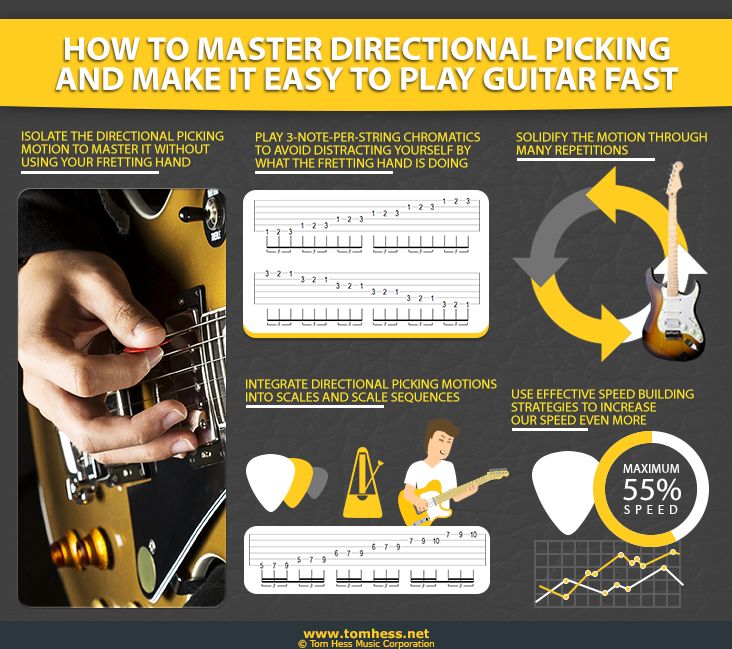How To Get Faster & Cleaner Guitar Technique Using Directional Picking
by Tom Hess
What is one of the most overlooked ways guitar players make their technique sloppy and slow?
Answer:
Using alternate picking for everything they play.
There is nothing wrong with alternate picking, but it can be a very inefficient technique that causes problems when used at the wrong times.
Fortunately, instead of trying to figure out the best times to use or not use it you can simply use directional picking technique.
What is directional picking?
This simply means that while picking, you always use a pick stroke that moves in the direction of the string you are switching to. For example, using a downstroke when moving to a higher (in pitch) string and an upstroke when moving to a lower string.
The result of using this technique:
Your picking technique becomes efficient and playing with fast guitar technique begins to feel effortless.
Changing over from strict alternate picking to directional picking is sometimes challenging for guitar players – but it doesn’t have to be.
Knowing why this happens helps you avoid any frustration as you develop better guitar technique.
Here is what to know:
Directional Picking Helps You Identify Mistakes In Your Current Playing
Directional picking naturally forces you to articulate notes better as you move from one string to the next. This helps you get faster guitar speed with better precision.
Guitar players who only play with alternate picking almost entirely neglect practicing the skill of articulation. This leads to notes sometimes sounding weaker and less clear. Spotting things like this is what takes your guitar picking and technique to a level much higher than before.

Holding Onto Less Efficient Technique Stops You From Playing How Your Really Want
One of the most frustrating things about getting better at guitar is correcting old habits that feel comfortable while trying out something new that feels difficult.
For many guitarists, it is too easy to return to their comfort zone. Good news is, this feeling of frustration won’t last. As you start making progress, you quickly begin feeling more confident and start becoming motivated by your newfound skills.
Plus:
You Don't Have To Completely Lose All The Skills You’ve Built Up Over Time
You don’t have to totally give up on alternate picking (or whatever style of playing you currently are used to). Arrange more time to practice things you’d normally use your usual picking style with using directional picking and less time playing with what feels comfortable for now.
After even just a few practice sessions, the new habit of using directional picking will feel much easier and you’ll see a lot of improvement in your overall guitar speed, cleanliness and technique.
You will start to replace your old less effective playing habits because directional picking feels easier and works better. This motivates you more and more to keep using the better approach.
Quick Tip For Applying Directional Picking Into Your Playing:
While picking through scales, use a lot of force to play the strings. This is great for syncing your hands up together, making faster playing feel effortless.
When doing directional picking, your pick needs to fall onto the next string during string changes. This motion should not be interrupted. This is just like sweep picking. Being able to do this consistently is critical for mastering this technique.
However, developing amazing guitar technique is about more than just directional picking. Find out how to play at a much higher level in your guitar technique right now by learning how very advanced guitarists think.
 About Tom Hess: Tom Hess is a guitar teacher, music career mentor and guitar teacher trainer. He teaches rock guitar lessons online to students from all over the world and conducts instructional live guitar training events attended by musicians from over 50 countries.
About Tom Hess: Tom Hess is a guitar teacher, music career mentor and guitar teacher trainer. He teaches rock guitar lessons online to students from all over the world and conducts instructional live guitar training events attended by musicians from over 50 countries.

